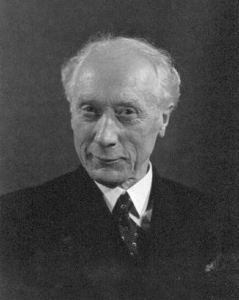History
ALEXANDER TECHNIQUE’S CREATOR
For in the mind of man lies the secret of his ability to resist, to conquer and finally to govern the circumstances of his life.
F.M. Alexander

The Alexander Technique was discovered by Frederick Matthias Alexander. Alexander was born in Tasmania, Australia in 1869. A premature baby and a sickly child, he grew up in a small secluded village. He loved nature, particularly horses and read a lot. From an early age Alexander was fascinated by Shakespeare. Being clever and quick to learn he started his first job at fifteen as a pupil-teacher at his school.
At seventeen he moved to a bigger town in Tasmania and at twenty to Melbourne, Australia, all the time troubled by ill-health. He had subsequently a few different clerical jobs and was earning a good living, but his passion lay in the theatre. Working during the day in the office, he spent his evenings reciting Shakespeare and, with growing popularity, planned to earn his living as an actor.
His reciting career was developing successfully until he started to experience problems with hoarseness and loss of voice. As it interfered with his work and passion Alexander was determined to find a cure. He visited many doctors and underwent different treatments to no avail. His voice would improve with rest from reciting and speaking but the hoarseness and loss of voice would reappear once he was on stage. The doctors were not sure what the problem was and were not unanimous in their diagnosis. Finally Alexander was told that he needed an operation. He decided against it.
From the observation that his voice recovered when he was not reciting Alexander concluded that it must be something he was doing with himself while reciting that was causing his problem. He made up his mind to discover what it was and spent months reciting in a room filled with mirrors to observe himself. Finally he discovered that while reciting he was tensing his neck muscles, pulling his head back and depressing his larynx. From further observation he became aware that in tensing his neck muscular tension across his body was triggered.
At first Alexander thought that this discovery solved his problem, to his puzzlement though he soon observed that no matter how much he tried not to tighten his neck and pull his head back, the moment he started reciting he was still doing it. Alexander spent a lot of time figuring out how to overcome his habitual reaction to the stimulus of reciting. Finally he discovered that he was able to make progress only when treating what he was doing with himself, his ‘use of himself’ as more important than reaching his goal of reciting. With further time spent on mastering this non-endgaining approach Alexander was able to continue his reciting career without voice problems, moreover his general health greatly improved.
He toured his native Tasmania and then New Zealand reciting and receiving more and more compliments on his voice and performance. In many towns he visited people with voice problems were seeking his advice. Observing those seeking his help, Alexander quickly realized that the interfering body tension he had believed to be particular to himself, was commonly present in other people. He started to share with others what he had discovered and many of those he taught testified to an improvement not only in their voice but also in their general health. With time he became so well-known for helping to solve breathing problems that people referred to him as ‘the breathing man’. Finally he gave up his now established reciting career and started to work full time as a teacher of the method he discovered – the Alexander Technique.
Alexander taught for almost sixty years in Australia, the United Kingdom and the USA. He taught many influential people of his day including the playwright George Bernard Shaw, novelist Aldous Huxley, philosopher John Dewey, and lawyer and politician Stafford Cripps as well as many leading doctors and scientists. His technique received increasing recognition and many doctors have believed that the Alexander Technique should be an obligatory part of a medical studies curriculum.
Alexander wrote four books about his technique: ‘Man’s Supreme Inheritance’ in 1910, ‘Constructive Conscious Control of the Individual’ in 1924, ‘The Use of the Self” in 1931 and “The Universal Constant in Living’ in 1941. They are all written in stylish, by now rather old-fashioned, prose and are full of descriptions of his experiences and observations as well as more general philosophical thoughts.
In the 1930s Alexander was persuaded to train teachers of his method so it could be passed on to following generations. From that time preparing future teachers became a big part of his work.
Alexander died in 1955 when he was 86 years old. He had continued teaching until a fortnight before his death.
Since Alexander’s death the popularity of his work has been steadily growing resulting in thousands of Alexander Technique teachers in many countries all over the world. Some of the best education institutions for musicians, dancers and actors offer individual Alexander Technique lessons to their students (e.g. Trinity Laban Conservatoire of Music and Dance in London, The Royal Academy of Music in London, The Juilliard School of Performing Arts in New York, The Boston Conservatory of Music, The Royal Conservatory of Music in Toronto). In recent years, the number of medical and scientific studies on the Alexander Technique has grown rapidly – you can read about their findings following links on https://www.alexandertechnique.com/research.htm
Contact me
If you have questions, write to me!